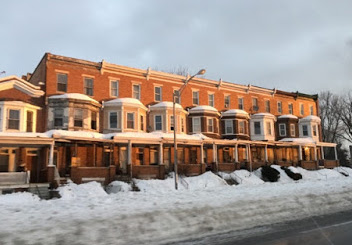The Department of General Services and the press have already dissected the promise and reported that almost none of that money is actually "new" money and that it was instead money already allocated to programs such as tax credits and the rental assistance program etc. It has become clear that the new money was mostly the sizable chunk of some $70 million added to the city's demolition program and that the Governor's heart was in demolition more than in rebuilding.
 |
| Eager Street deconstruction |
After this somewhat sobering realization, it is time to think about the next steps. Housing Commissioner Graziano repeated on WYPR's Midday yesterday that his priority is rebuilding and that demolition remains "the last resort" where "rebuilding is not feasible". He emphasized that his department, i.e. the City will remain in charge of what will get demolished and that the State's Stadium Authority will only oversee the contracts for demolition. So far so good. Here are some burning questions:
- Can some of the big chunk of demolition money be converted to rebuilding money?
- Will demolition be done in a manner that uses the "Baltimore Protocol" developed in the Middle East area in conjunction with the EBDI demolitions behind Hopkins?
- Will demolition be done in a way that local people will get jobs and that the community will be strengthened?
- Will the community have a say in what gets demolished?
- What is the plan for areas where demolition occurred?
- Will the community have a say in planning the future of those demo areas?
- How can the community become an active player in future development for example through community land trusts?
- What is the historic preservation perspective in all of this?
Lets go through these questions in some more detail.
 |
| "Traditional" demolition and dust control |
Rebuilding: Graziano explained that restoring four houses can cost as much as a million and that redirecting the millions of dollars for rehab wouldn't get very far. Maybe this thinking needs some innovation. Maybe there are ways to rehab buildings far cheaper if it is done with local labor and sweat equity in an expansion and innovative adaptation of the Habitat for Humanity approach. Local community development corporations such as the one in Druid Heights have tried for years to create a rehab workforce to create affordable rentals at a far lower cost than the commercial approach with competitive bidding among for profit contractors. However, these organizations are cash strapped and are trying too many things already. A pilot program of local workforce development and the creation of a non-profit rehab company would be a great use of re-dedicated demo funds. A few millions invested this way would, indeed, go a long way! Community Land Trusts can be part of the rebuilding scenario.
Lead dust during demolition: The so-called "Baltimore Protocol" should absolutely be applied to any demolition where occupied homes are nearby. It requires extensive soaking of demo structures ahead of the backhoe, air testing, sidewalk sweeping and cleanup and it requires that rubble will have to be hauled away within 24 hours and before it can dry out and blow dust around.
 |
| DHCDC Director Roscoe Johnson tours Druid Heights to the Mayor in October 2015 |
Still, "deconstruction" would be even better.
Manual deconstruction instead of mechanical demo: Graziano stated that Housing requested from the Stadium Authority to greatly expand the deconstruction pilot in which building materials such as bricks, lumber, marble stoops and possibly wood floors are salvaged and recycled instead of all tossed into a landfill. The process has been piloted by two groups in the past and is "impressive" as the Commissioner put it. Most importantly, it can be the front end of workforce development for the construction crews noted above. Re-entry folks (former addicts or convicts) can begin with deconstruction and step up to construction (of potentially their own future homes).
Community participation: Hogan's announcement has been blasted for having occurred without community consultation. The future of West and East Baltimore needs to be planned with a long-term perspective and with those who have survived in the communities during decades of decay in a pivotal role. A sustainable and livable future community cannot be achieved with a reactive response to blight through demolition but needs a pro-active strategy that includes services, open spaces, social justice and transportation. Community "visions" have been prepared endlessly. It is time to dust them off, update them and see if they are robust enough for creating a bright future in which blighted communities become repopulated and vibrant again.
 |
| Barclay-Old Goucher has become a model of strategic redevelopment |
Preservation: The communities of West Baltimore supported the application to recognize most of the area as a historic "National Register District" due to its rich social and architectural history. It is vitally important that this history does not get bulldozed because it is the biggest asset the community has to leverage a better future. That historic preservation is a great economic development tool has been proven across the country.
During the US Conference of Mayors last week it became obvious that there isn't much going on in Baltimore that the about 300 major city mayors look up as beacons to show them the way in their own cities. How to rebuild large devastated communities in a holistic, sustainable manner that considers health, social justice, equity, workforce development, access and "virtuous cycles" could become a Baltimore model to be proud of. Willing groups, experiences, pilots and insights are plentiful. Its time to scale it up. At this point it is mostly a matter of connecting the dots.
Klaus Philipsen, FAIA













































